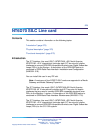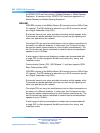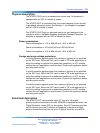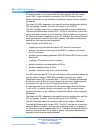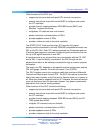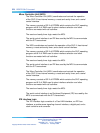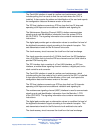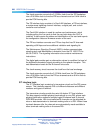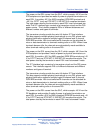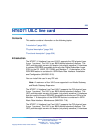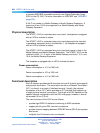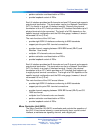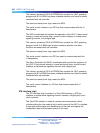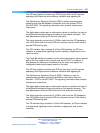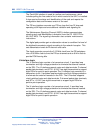
Functional description 381
The power on the DSL comes from the SILC, which accepts –48 V from the
IPE backplane and provides two watts of power to physical terminations on
each DSL. It provides -48 V for ANSI-compliant ISDN BRI terminals and
–40 V for CCITT (such as ETSI NET-3, INS NET-64) compliant terminals.
The total power used by the terminals on each DSL must not exceed two
watts.The S/T interface logic consists of a transceiver circuit and the DSL
power source. This interface supports DSLs of different distances and
different number and types of terminals.
The transceiver circuits provide four-wire full duplex S/T bus interface.
This bus supports multiple physical terminations on one DSL where each
physical termination supports multiple logical B-channel and D-channel
ISDN BRI terminals. Idle circuit-switched B-channels can be allocated for
voice or data transmission to terminals making calls on a DSL. When those
terminals become idle, the channels are automatically made available to
other terminals making calls on the same DSL.
The power on the DSL comes from the SILC, which accepts -48 V from the
IPE backplane and provides 2 watts of power to physical terminations on
each DSL. It provides -48 V for ANSI compliant ISDN BRI terminals and -40
V for CCITT (such as ETSI NET-3, INS NET-64) compliant terminals. The
total power used by the terminals on each DSL must not exceed 2 watts.
The S/T interface logic consists of a transceiver circuit and the DSL power
source. This interface supports DSLs of different distances and different
numbers and types of terminal.
The transceiver circuits provide four-wire full-duplex S/T bus interface.
This bus supports multiple physical terminations on one DSL where each
physical termination supports multiple logical B-channel and D-channel
ISDN BRI terminals. Idle circuit-switched B-channels can be allocated for
voice or data transmission to terminals making calls on a DSL. When those
terminals become idle, the channels are automatically made available to
other terminals making calls on the same DSL.
The power on the DSL comes from the SILC, which accepts –48 V from the
PE backplane and provides 2 watts of power to physical terminations on
each DSL. It provides -48 V for ANSI-compliant ISDN BRI terminals and –40
V for CCITT (such as ETSI NET-3, INS NET-64) compliant terminals. The
total power used by the terminals on each DSL must not exceed 2 watts.
Nortel Communication Server 1000
Circuit Card Reference
NN43001-311 01.04 Standard
Release 5.0 23 May 2008
Copyright © 2003-2008, Nortel Networks
.



